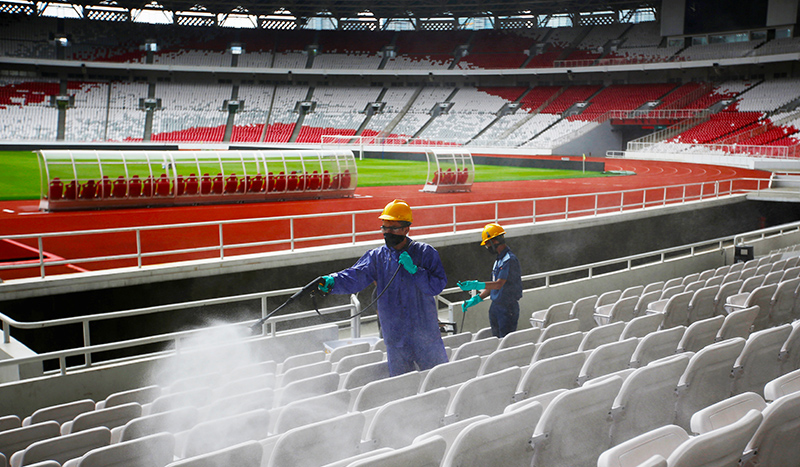<span style="color: #9c9c9c;">According to the fifth edition of PwC’s Sports Survey, growth in the broader sports industry, including sports federations, broadcasting and marketing, is expected to decline significantly over the next few years with many industry execs not expecting a full recovery until 2023 or later.
PwC received 780 responses between June and August 2020 through an online questionnaire distributed to sports industry leaders around the world. The respondents spanned across a wide range of organizations with sports federations making up 22 percent; broadcasters and sports marketing agencies, about 10 percent each; and brands/sponsors, 6 percent. The rest included leagues/event organizers, teams, sports technology companies, consultancies, and academia.
Fully impacted by COVID-19, the sports market is predicted to slow to an annual growth rate of 3.3 percent in the next 3-to-5 years, down from 8 percent over the past 3-to-5 years, according to its survey. Thirty percent of respondents expect the growth rate to be zero or below.
The Middle East and Asia, fueled by robust governmental support, upcoming mega-events and overall growing commercial maturity, reported the most optimistic forecast. Africa also anticipates steady growth thanks to an increasing influx of investments and partnerships.
The pandemic, however, has “significantly lowered confidence” in Europe, the Americas and Australasia. Respondents from North America saw growth slowing to 3.6 percent on average over the next 3-to-5 years, down from 7.7 percent growth over the previous 3-to-5 years.
Asked when they thought the sports industry would fully recover to pre-COVID-19 levels, 43.4 percent of respondents indicated by 2022; 27.1 percent, 2023; 10.9 percent, 2024; and 5.7 percent, 2025. Just 8.7 percent of respondents see full recovery by 2021.

“COVID-19 has revealed systemic weaknesses within the sports sector which makes a scenario of imminent recovery highly unlikely. The industry is in for a longer period of recovery and reorientation,” PwC wrote in its report. “Beyond the outright cancellation or postponement of major events, competitions that did restart are suffering from severe event-day revenue shortfalls, which have frontally impacted sports organizations (starting with the smallest). For their part, participation sports have entered a long, challenging period as people shy away from mass gatherings.”
PwC also noted that the pandemic has contributed to the redesign of sports calendars with the benefit of experimenting with new formats but, also risking the balance of schedules already at risk.
Asked, relative to other industries, how well the sports industry was prepared for COVID-19, 25.5 percent indicated “very poor” and 31.0 perfect indicated “below average.” Of the rest, 28.4 percent indicated “average” and 13.0 percent “above average.”
PwC wrote in its study, “Like all industries predicated on events and mass gatherings, the unprecedented health crisis brought about by COVID-19 has impacted the sports market at its very core. The sports sector is just not used to external crises, as its major blowbacks often come from within the industry itself (e.g. corruption and doping). This has shaken the sense of security and untouchability in which the sector has wrapped itself in recent years. In many instances, risk management and contingency plans were not in place. Short-sighted funding, cash flow and cost management practices were drastically exposed.”
PwC said that beyond the structural risks inherent in the industry’s natural ties with crowds and events, the crisis has accelerated underlying trends, including shifting consumption behaviors, mutation of revenue models and the arrival of external investors.
PwC wrote, “It’s vital that sports organizations fully address these issues with the perspective of turning them into opportunities. All in all, the underlying challenges only shed light on the importance of innovation, pro activism and cooperation to protect and support the growth of the industry over the medium- and long-term. With regard to collaboration, we foresee the end of the historical, in-house versus outsourcing binary model in favor of more symmetrical schemes, driven by value co-creation and shared accountability of results.”
Other findings in the report:
- Betting and fantasy’s growth potential are predicted to become key industry drivers in the next 3-to-5 years, with an anticipated yearly growth of 7.2 percent. The favorable forecasts are mainly due to the rapid acceleration of the betting market in the U.S. since the lifting of the federal ban in 2018. Licensing and merchandising are expected to see the second-fastest growth rate over the next 3-to-5 years climbing 3.4 percent; followed by media rights, up 3.2 percent; and sponsorship and advertising, ahead 2.2 percent. Ticketing and hospitality are expected to remain flat.
- Esports is the fastest-growing category benefiting from unprecedented exposure in the mainstream media during the lockdown. The simulated sports genre, which temporarily turned into a substitute for real, physical sports, is ranked first by respondents among sports by its potential to grow revenue. Benefiting by its global reach, global football (soccer) and basketball landed in the second-highest growth potential tier. The third-highest growth tier was represented by urban sports such as skateboarding, as well as tennis and golf. The fourth growth tier was represented by cycling, motorsports, rugby, and American football.
- Digital has strengthened its position as a major opportunity driver with survey results showing that sports leaders recognize the digital fan experience as a top priority, although few organizations have managed to deliver it in a way that allows it to acquire and retain fans sustainably. PwC wrote, “The COVID-19 pandemic has significantly weakened physical entertainment, reinforcing the value of both immersive and interactive technologies to compensate for sports’ diminished visual and social experiences.”
The full report is here. Photos courtesy AAAS, World Economic Forum
















